Famous Plazas of Madrid

What would be Madrid without the plazas of the city - the witnesses of the history, places of getting together, meeting points of the people? Sooner or later, one will pass many plazas; the first plaza will be the Plaza Mayor, the most inmportant plaza of Madrid.
Plaza Mayor
The most easy way to get to the Plaza Mayor is by the subway station Sol (L1, L2, L3). From there, some signpostings will indicate the way to the Calle Mayor.
The building of the Plaza Mayor was started by Juan de Herrera, who also participated in the building of the Escorial, around the year 1590 and continued by Juan Gómez de Mora and finall.y finished in the year 1619. The ordering party of the plaza, where later on, almost all the municipal life took place, were Felipe II and later Felipe III. The latter has been representated through the horseman monument in the centre of the plaza. But the monument was not placed earlier than the year 1847 on the plaza, as originally, Felipe III was standing in the complex of the Casa de Campo.
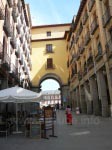
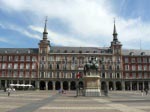
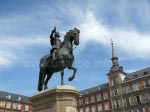
As already mentioned, the plaza was the central point of the former municipal life. On this plaza, people negotiated, the city market took place there and it was the meeting point in order to exchange the latest news. Not only the daily life, but also events as theatre performances, bull fights, sanctifications and burning of witches attracted the people.
Today, the most important buildings of the time are still existent, the Casa de Panadería and Casa de Carnicería. In the Casa de Panadería, the grain was once stored and bread was sold. The name of the Casa de Carnicería comes from its former function of a butchery; today, it accommodates the tourist information centre.
Compared to all the other plazas, the Plaza Mayor is the only plaza that is almost permanently surrounded by some buildings of the same building style symmetrically. The accesses connect, amongst others, the streets Calle de Toledo, Calle Mayor and Calle de Atocha.

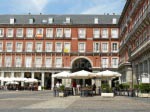
The Herrera - style of the plaza, named after Juan de Herrera, often appears in Madrid. The abundant archs and sometimes many floors and spires are characteristical for that building style. In former times, the plaza had five floors, a thing that the Madrileneans did not like at all; After some numerous fires, the plaza had to be urgently restored - thus, people abstained from restoring all five floors and left the plaza the way it is today.
The plaza is of a size of approximately 120m x 90m, but specially in the evenings it appears to be smaller: then, the Plaza Mayor is a popular place to walk thrugh for the night lovers as also the perfect place to experience the evening flair and to rest from the day. The latter happens in form of a massage that is oftenly offered by Asians.
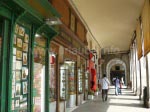

Also during the day there is hustle and bustle: each Sunday morning, the stamp exchange takes place; in the winter time, the christmas market takes place there. The plaza that is one of the main destinations of the visitors also attracts the painters who want to sell their paintings and make some portraits of the people. Around the plaza, there are diviners and - very interesting - oftenly poeple that remain in a position without moving. They do not "awake" until somebody throws a coin to them. The special thing of them is their appearance; some of them are sprayed with silver colour (inclusive the face and the hair) or even covered clay, so that the featurs are not recognizable.
Under the archs of the plaza there are numerous souvenir shops and cafés and restaurants, but these most probably offer their culinary specialities at expensive prices. Tip: in order to get refreshed, the best is to get to one of the numerous bars around the plaza - there, one can get something to eat to resonable prices.
Plaza de la Villa
A less outstanding but special plaza is the Plaza de la Villa in the Calle Mayor. The apparently oldest civil plaza of the 15th century has kept its beautiful oldtown ambience. It is surrounded by the city hall, the Casa de Cisneros and the Casa&Torre de los Lujanes.
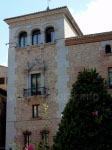
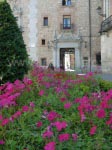
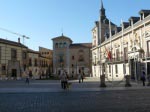
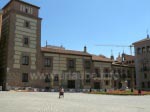
The city hall was planned in the year 1644 by Juan Goméz de Mora, who also took part in the building of the Escorial, and finalized by José de Villareal. In the city hall, the gobelin collection, the meeting hall and the Salon de Goya with his painting "Allegorie Madrids" are worthwhile to view. The Casa de Cisneros is located at the south of the plaza and was originated in the year 1537 by Benito Jiménez de Cisneros. In the year 1909, the councillor acquired the building that today is the residence of the burgomaster of Madrid.
The Casa&Torre de los Lujanes is a civil building of the 15th century. It is a gothic relict - a rarity that is seldom in Madrid.
Plaza de Oriente
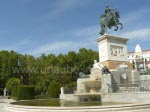
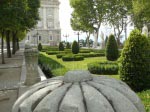
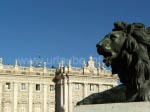

Starting from the subway station Opera (L2, L5, shortly before arriving to the Palacio Real, one gets to the Plaza Oriente. The very dapper plaza suggests that the nobles were in charge of it. Interestingly, the initiative did not come from the Spaniards but from the brother of Napoleon, José I, after the invasion of the year 1808. After the end of the war, the building works were interrupted, as Fernando VII continued to reign. His daughter Isabel II made the works to be continued. The plaz around the subway station Opera is named after her.
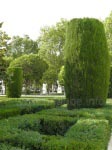
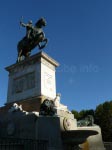
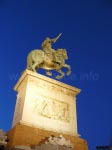
The arrangement of the plaza of that time is still the same today: the horseman statue of Felipe IV with the flat water installation and surrounded by trees and cut bushes form the centre of the symmetrically arranged plaza, a thing that can be seen specially well from the royal theatre, the Teatro Real.
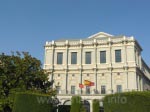
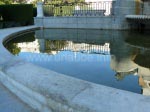
The Teatro de la Opera, the way it is sometimes also called, was built from the year 1818 up to 1850 and inaugurated by Isabel II. The specially successful performnces that took place there were the ones of Verdi, the Wagner Operas and the russian ballet. From the year 1960 up to 1966, mainly concerts took place there and not before 1997, the operas took place again. The tendence to the music remained; at the side of the Plaza de Isabel II there is the Real Conservatorio de Música.
Plaza de España
The Plaza de España that is located at the same-named subway station of the line 10 was arranged according to the sense of the city in the year 1899 and therewith relatively late. Previously, it was mainly used for military purpposes.From the year 1930 an increasing amount of buildings were originated, as for example the former head office of the public health , the building Edificio España and the Torre de Madrid.
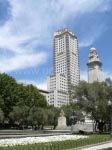
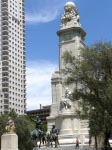
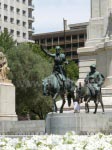
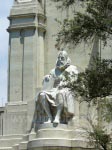
Close to the plaza there is the church San Marcos that was already built in the late 18th century to the honour of Felipe V. It was built by Ventura Rodríguez and considered as one of the most representative churches of the baroque of Madrid.
The monument of Cervantes rises up over the trees: in front of the column, the famus poet lordly sits on His view falls to two smaller horseman statues that represent the protagonist Don Quijote from the same - named novel as also his knave Sancho Panza. At the other side of the column there is a beautiful semicircular fountain which water runs in a cascade into a further water level.
While the traffic around the Plaza de España runs on multi-laned roads, the people on the plaza seem to relax without any problem. The Plaza de España communicates - or separtes, depending on the point of view - the antique Madrid with the modern Madrid: it is the intersection between the oldtown and the city area of business, trffic, cinemas, shopping centres - or, in one Word: Gran Vía.
Plaza de Colón
The Plaza de Colón is probably not the most beautiful plaza of Madrid, but due to its abstract arrangement and missing crowds of people worthwhile to visit. In former times, the plaza that is located right at the subway station Colón (L4) was surrounded by trees, palaces and the Real Fábrica de Moneda. Today, nothing reminds on that at the traffic junction; modern high buildings dominated this area.
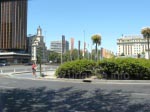
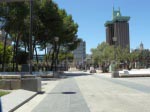
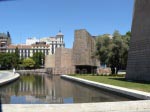
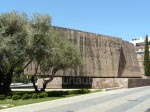
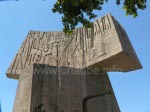
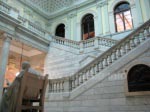
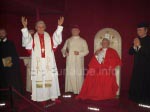
The plaza is dedicated to the discovering of America and to Columbus. The three metres heighted monument of Columbus and the Columbus Column heighted 15 metres, that was previously placed in he centre of the plaza, are outstnding. As it was the case of the Jardines del Descubrimiento de América (Gardens of the Discovering of America), the statue was replaced to the south. On the place that hardly looks like a garden, there are four sculpture blocks positioned since the expanding , that are supposed to represent the discovering of America.
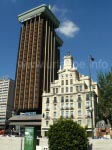
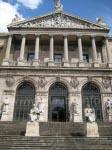
At the Plaza de Colón there is, by the way, the municipal cultural centre (Centro cultural de la villa), to which some theatre- and exhibitions rooms as also a water wall belong to. Close to the Plaza de Colón there is the National Library that contains the whole collection of Cervantes' and is considered as one of the most valued libraries of Europe. The building of the National Library ccommodates, by the way, also the Museo Arqueológico Nacional (Archeological National Museum).
Further Buildings of the surroundings of the Plaza Colón that are worth to be mentioned are the towers Torres de Jerez and the waxworks (Museo de Cera) at the subway station Colón.
Plaza de Cibeles
By leaving the subway station Banco de España (L2), the first view does not fall to the Cibeles-fountain, after which the plaza is named; No, at first, the pompous building of the headquarters of the post office catches one's eye, a building that was planned by Antonio Palacios and Julián Otamendi but not built until 1905 - 1917.
The fist elements of the plaza were already originated in the 18th century, as also the funtin of the greek goddess of love Kybele (Spanish: Cibeles). The Kybele is positioned in a carriage that is pulled by two lions. The plans for the today's city emblem of Madrid were created by von Ventura Rodríguez; the fountain was built by Francisco Gutiérrez and Robert Michel in the year 1782. Up to the 20th century, Kybele was looking to the direction of the Paseo del Prado, after that, the fountain was turned by 90º facing the Puerta del Sol.
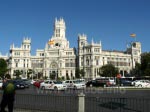
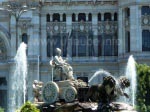
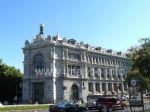
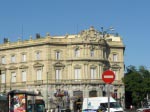
Beside the building of the post office headquarters there is the state bank of Spain, the Banco de España, that was originated in the year 1884 by Eduard Adaro and Severiano Saínz de Lastra.
At the northeast of the plaza there is the Palacio de Linares. It was built in the 19th century and designed by Carlos Colubi. Today, the Casa de América is accommodated there, in which the events and exhibitions about South America take place.
In front of the Palacio de Linares there is the Palacio de Buenavista. Today, the Ministerio de Defensa (Ministry of Defence) is accommodated there. The building was built as per the order of the Duchess of Alba and designed by the arquitect Juan Pedro Arnal and built from the year 1777 up to 1782. After the death of the Duchess, the city acquired the Palacio de Buenavista in the year 1802.
The Plaza de Cibeles is one of the numerous traffic junctions of Madrid. From there, the night buses depart (Buhos, in English:owl) it connects the Paseo del Prado, the 12-lane Paseo de Recoletos and the also 12-lane Calle Alcalá. 200m further ahead, there is the monument of Carlos III: The Puerta de Alcalá from the 18th century.

Back to the index Madrid
Author: Stefanie Kotulla; Copyright 2008-2008: Patrick Wagner, www.tourist-guide.biz
|